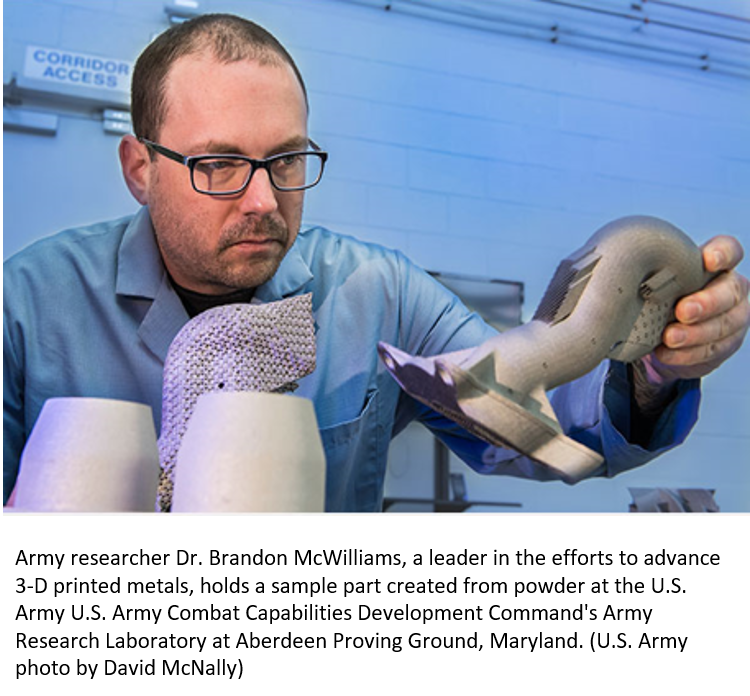Market Data

March 15, 2019
Army Studies 3-D Printing of Steel Parts, Even on the Battlefield
Written by Sandy Williams
“Your tank broke down? No problem, we’ll just 3-D print a steel replacement part.” Someday this scenario may be a reality for U.S. Army technicians in the field.
Researchers at the U.S. Army Combat Capabilities Development Command’s Army Research Laboratory are working on a process that will take powdered steel and transform it with lasers into reliable and ultra-strong metal parts using 3D printing.
I think it’s going to really revolutionize logistics,” said Dr. Brandon McWilliams, a team lead in the lab’s manufacturing science and technology branch. “Additive manufacturing is going to have a huge impact on sustainment.”
Instead of carrying truckloads of spare parts, said McWilliams, in the future, troops will create parts with a portable 3-D printer and a cache of raw material.
An alloy developed by the U.S. Air Force, called AF96, has been adapted to a powder form for use in the process. Using a method called Powder Bed Fusion, a 3-D printer laser melts the powder in a pattern upon a build plate. Additional layers of powder are added and melted until the part is complete.
AF96 builds on the properties of Eglin Steel, a high strength, high impact steel developed in the early 2000s. ES-1 contained relatively high amounts of nickel and cobalt to achieve its balance of strength and toughness but was too costly to produce in large quantities. AF96 steel contains little in the way of expensive alloy content and relies on special processing techniques and mechanisms to develop a steel with the required strength and toughness level.
A patent summary for AF96 describes the steel composition based on weight as “essentially about 0.24 percent to about 0.32 percent carbon, about 2 percent to about 3 percent chromium, about 0.50 percent to about 1.50 percent molybdenum, about 0.05 percent to about 0.35 percent vanadium, about 1 percent manganese or less, about 3 percent nickel or less, about 1.50 percent silicon or less, with minimal impurities, and the balance consisting essentially of iron.”
“We’re able to print up parts with internal structures that they would not necessarily be able to create with that much dimensional accuracy where they try to use mill or machine part,” said Dr. Andelle Kudzal, a materials engineer on McWilliam’s team.
The key to using the process is certification, said McWilliams. The 3-D printed parts need to work as well as OEM parts in a battlefield scenario.

“We’ve printed some impeller fans for the M1 Abrams [Main Battle Tank] turbine engine and we can deliver that part — they can use it, and it works,” McWilliams said. “But it’s not a qualified part. In terms of a battlefield scenario, that may be good enough to get your tank running again for hours or days if that’s important to the mission, but on the other hand, we still need to be able to answer, does this perform as good as the OEM part? Does this perform better?”
The Air Force developed AF96 for use in bunker-busting bomb applications, but the process has wide-ranging applications for Army use.
“We have interest from the ground combat vehicle community, so it could be used for replacement parts,” said McWilliams. “A lot of our parts in ground vehicles now are steel. So, this could be dropped in as a replacement, not having to worry about material properties because you know it’s going to be better.”







